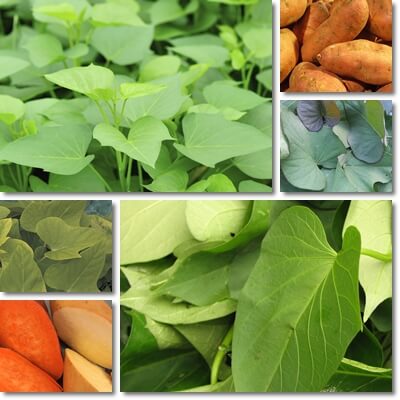Did you know that you can eat sweet potato leaves? In addition to being edible and as safe to eat as any other leafy green vegetable, sweet potato leaves are also packed with nutrition. The nutritional value of sweet potato leaves is in line with the nutrition of other leafy greens such as spinach, kale, chard or sorrel. Not only this, but the leaves are a source of important benefits for health. Eating sweet potato leaves is good for blood coagulation and a source of anti-inflammatory benefits. Sweet potato leaves lower blood pressure numbers and help build strong bones and teeth, among other benefits.
What are sweet potato leaves?
As per their name, sweet potato leaves are the leaves of sweet potatoes, colloquially known as yams in North America (but not true yams). While sweet potatoes themselves are tubers, and classified as root vegetables, sweet potato leaves are culinary leaf vegetables, a status shared by spinach, kale, chard, sorrels and other leafy greens. Sweet potato leaves are not grown intentionally for consumption, which makes them a sort of incidental vegetable, but they are often grown for ornamental purposes.

Are sweet potato leaves edible?
Yes, you can eat sweet potato leaves, both raw and cooked. Any variety of sweet potato identified by the scientific name Ipomoea batatas has edible leaves. That includes the more common orange-fleshed sweet potatoes (also commonly known as yams in North America), but also yellow, pink, red, purple, violet, white or cream-fleshed sweet potato varieties. Of course, there are also ornamental sweet potato leaves, grown for their beauty and decorative uses.
Sweet potato leaves are not just edible, but also safe to eat, as opposed to regular potato leaves which are poisonous. Although sweet potatoes are distantly related to regular potatoes, the sweet potatoes themselves and their leaves do no contain the toxic glycoalkaloids solanine and chaconine that render different parts of the regular potato plant poisonous (e.g. leaves, stems, flowers, even skin and flesh).
What do sweet potato leaves look like?
The sweet potato plant grows a long vine aboveground that can extent over many meters, similar to pumpkin vines who also have edible leaves (also see the benefits of pumpkin leaves). Depending on the variety, sweet potato leaves can be heart-shaped, kidney-shaped, triangular-shaped, spear-shaped, with rounded or pointed tips, different kinds of leaf edges, and can range from light green to deep green to deep purple. For a better idea of what sweet potato leaves look like, take a look at the images below.
What do sweet potato leaves taste like?
The taste of sweet potato leaves is typical of leafy greens. Young leaves, shoots and vine tips taste pleasantly bitter, with a low taste intensity, and are generally tender enough to be eaten raw. By comparison, older sweet potato leaves are tougher, requiring some chewing, and bitter-tasting, with a moderate to intense bitter flavor. Usually only the young leaves, shoots and vine tips are eaten, although the older leaves are also edible.

Sweet potato leaves nutritional information
The nutrition of sweet potato leaves is in line with the nutrition of other leafy green vegetables. For instance, sweet potato leaves are low in calories and protein and very low in fat. They are a moderate source of carbohydrates and high in dietary fiber. Sweet potato leaves are naturally high in carotenoid antioxidants such as beta-carotene with vitamin A activity, but have no retinol, the vitamin A form specific to animal foods. The raw leaves contain modest amounts of vitamin C and several B vitamins (B1, B2, B3, B5, B6), but no vitamin B12, almost no vitamin B9 and no vitamin D.
Sweet potato leaves are an exceptional source of vitamin K1, roughly 83% of the entire daily requirement of vitamin K for adult women per 1 cup (64 g) of steamed leaves, and 58.8% for men. Sweet potato leaves are also high in dietary potassium and magnesium and contain small amounts of iron, calcium, phosphorus and trace amounts of sodium, selenium and zinc.
Sweet potato leaves: nutrition facts per 100 g raw leaves
- Energetic value: 42 kilocalories/kcal
- Carbohydrates content: 8.82 grams/g of carbs
- Fiber content: 5.3 g of fiber
- Protein content: 2.49 g of protein
- Fat content: 0.51 g of fat
- Water content: 86.8 g of water
Vitamins in sweet potato leaves:
- Vitamin A: 189 micrograms/mcg
- Vitamin B1: 0.156 milligrams/mg
- Vitamin B2: 0.354 mg
- Vitamin B3: 1.13 mg
- Vitamin B5: 0.225 mg
- Vitamin B6: 0.19 mg
- Vitamin B9: 1 mcg
- Vitamin B12: 0 mcg
- Choline: –
- Vitamin C: 11 mg
- Vitamin D: 0 mcg
- Vitamin E: –
- Vitamin K: 302.2 mcg (the average adult woman requires 90 mcg of vitamin K per day, while men 120 mcg of vitamin K).
Minerals in sweet potato leaves:
- Calcium: 78 mg
- Copper: 0.033 mg
- Iron: 0.97 mg
- Magnesium: 70 mg (the average adult needs 400-450 mg of magnesium a day)
- Manganese: 0.229 mg
- Phosphorus: 81 mg (the average adult needs 700 mg of phosphorus a day)
- Potassium: 508 mg (the recommended daily intake is 4,500 mg a day)
- Selenium: 0.9 mcg
- Sodium: 6 mg (trace amount with no perceivable effects on health)
- Zinc: 0.26 mg
Antioxidants in sweet potato leaves:
- Carotenes: beta-carotene with vitamin A activity (2217 micrograms/mcg), alpha-carotene with vitamin A activity (42 mcg), beta-cryptoxanthin with vitamin A activity (58 mcg)
- Xanthophylls: lutein and zeaxanthin (14720 mcg)
- Lycopene: 0 mcg
- Anthocyanins: quantity unknown
- Chlorophyll: quantity unknow
What are the benefits of sweet potato leaves?
What are sweet potato leaves good for? Here are some of the top benefits of the leafy greens:
- Good for weight loss: sweet potato leaves are low in calories, carbs and fat and can help you lose weight by reducing your daily calorie intake.
- Benefits for constipation: eating sweet potato leaves provides dietary fiber which regulates transit and softens stools, relieving constipation naturally.
- Depurative action: sweet potato leaves have laxative and diuretic properties and help detoxify the blood, bowels and kidneys.
- Benefits for visual acuity, color vision and low-light vision thanks to a generous content of beta-carotene and other carotenoid antioxidants with vitamin A activity.
- Benefits for high blood pressure: eating sweet potato leaves lowers high blood pressure numbers via a generous content of potassium and magnesium.
- Reduced risk of atherosclerosis: vitamin K in sweet potato leaves regulates calcium metabolism, ensuring it gets absorbed into bones and teeth instead of heart valves and the inside of blood vessels in the form of plaque.
- Benefits for high cholesterol: the cholesterol-lowering properties of sweet potato leaves are owed to a good dietary fiber content which reduces cholesterol absorption, and a low energetic value which supports weight loss.
- Anti-bleeding effects: vitamin K in sweet potato leaves activates blood coagulation processes and helps prevent blood loss.
- Good for bones and teeth thanks to an exceptional content of vitamin K which regulates calcium absorption in bones, and small amounts of calcium and phosphorus to contribute to building bones.
- Good food to eat for osteoporosis: sweet potato leaves contain vitamin K, magnesium, phosphorus and calcium which contribute to bone integrity and bone health.
- Benefits for pregnant women: sweet potato leaves combat pregnancy-related constipation and high blood pressure during pregnancy via good amounts of dietary fiber, potassium and magnesium, but no sodium. The leaves also help protect teeth health during pregnancy thanks to vitamin K.
- Anti-inflammatory food: sweet potato leaves contain vitamin K, vitamin C and pro-vitamin A which lower levels of inflammatory markers in the body such as Interleukin-6 and C-reactive protein.
- Antioxidant benefits from vitamins C and K, manganese, copper, carotenes, xanthophylls and anthocyanins which scavenge for free radicals and help limit and repair cell damage caused by oxidative stress.
- Anticancer benefits: vitamins C, K and pro-vitamin A, but also carotenes, xanthophylls and purple anthocyanin antioxidants exert anti-inflammatory, antioxidant, anti-proliferative, anti-tumor and apoptosis-inducing effects.
- Good food to eat for healthy hair, skin and mucous membranes thanks to a high content of carotenoid antioxidants with vitamin A activity.
- Digestive benefits: bitter foods such as sweet potato leaves and other leafy greens act as natural digestifs and help digestion along.
Sweet potato leaves side effects and contraindications
- Side effects: digestive upset and loose stools.
- Contradictions: anyone currently receiving anticoagulant medication for treating blood clots is advised to avoid foods high in vitamin K such as sweet potato leaves and other leafy greens.
- Risks: possible contamination with bacteria or viruses that can cause foodborne illness. Contamination can occur anywhere along the distribution line, for example, as a result of the use of improperly treated sewage water for crop irrigation or as a result of improper handling.
